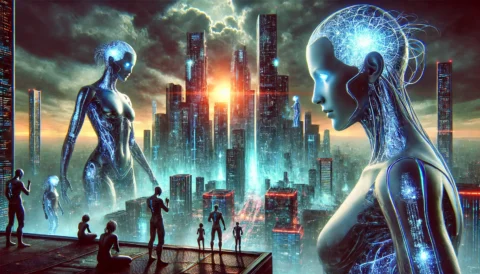Imagine a world where your favorite games run flawlessly at 4K resolution, where creative projects render in seconds instead of hours, and where advanced AI computations are handled with ease—all thanks to a single piece of hardware. What if you could future-proof your entire system with a GPU that not only redefines performance but also sets new benchmarks for innovation? Welcome to the era of the NVIDIA RTX 4090, the flagship graphics processing unit (GPU) that’s taking the world of gaming, content creation, and high-performance computing by storm.
In this comprehensive guide, we’ll explore everything you need to know about the NVIDIA RTX 4090. Whether you’re a hardcore gamer, a professional content creator, a data scientist, or simply a tech enthusiast, this post will provide you with a deep dive into the features, history, and real-world applications of the RTX 4090. We’ll cover:
- Introduction: Why the NVIDIA RTX 4090 is a game changer and what this guide will help you discover.
- What is NVIDIA RTX 4090?
A clear definition of the RTX 4090, including its core components and technological significance. - Historical Context and Evolution:
A look back at NVIDIA’s GPU evolution—from early models to the groundbreaking RTX series—and the journey to the RTX 4090. - Key Features and Benefits:
Detailed insights into its state-of-the-art Ada Lovelace architecture, performance metrics, power efficiency, and advanced features like ray tracing and DLSS. - Real-World Applications and Case Studies:
How the RTX 4090 is revolutionizing gaming, creative work, and AI research with real-life examples and success stories. - Actionable Tips, Strategies, and Best Practices:
Expert advice on optimizing your system, overclocking, cooling solutions, and maximizing your return on investment. - Frequently Asked Questions (FAQ):
Answers to common questions and misconceptions about the NVIDIA RTX 4090. - The Future of NVIDIA RTX 4090 and GPU Technology:
Emerging trends and innovations shaping the future of graphics processing and high-performance computing. - Conclusion and Call-to-Action:
A succinct summary of key points and a compelling invitation to upgrade your system, share your experiences, and join the conversation.
Let’s embark on this journey to unlock the full potential of the NVIDIA RTX 4090 and discover why it’s the GPU that’s setting the gold standard for performance and innovation in today’s digital age.
1. Introduction: The Power of the NVIDIA RTX 4090
Imagine a world where your most demanding games run flawlessly at 4K, where rendering a high-resolution video takes minutes instead of hours, and where complex AI computations that once seemed impossible are now performed in real time. This isn’t a distant dream—it’s the reality ushered in by the NVIDIA RTX 4090.
Did You Know?
Recent benchmarks have shown that the RTX 4090 can deliver up to 50% more performance than its predecessor, the RTX 3090, making it one of the most powerful GPUs ever made. With its state-of-the-art Ada Lovelace architecture, this GPU is not only a boon for gamers but also a critical tool for creators and professionals pushing the boundaries of AI and high-performance computing.
Engaging Question:
Have you ever wondered what it takes to power the most immersive gaming experiences or the most detailed digital creations? What if you could harness the full potential of cutting-edge technology to transform your computer into a powerhouse of creativity and performance?
In this guide, we’ll delve into every facet of the NVIDIA RTX 4090. We’ll start by defining what the RTX 4090 is and exploring its historical evolution from previous NVIDIA generations. Then, we’ll break down its key features—from its revolutionary architecture and lightning-fast performance to its advanced ray tracing capabilities and power efficiency. We’ll share real-world examples and case studies that highlight its impact across gaming, content creation, and AI research. Plus, you’ll gain actionable tips and best practices to optimize your system, along with answers to frequently asked questions. Whether you’re a gamer, a professional creator, or a tech enthusiast, this guide will equip you with everything you need to know about the NVIDIA RTX 4090.
Let’s dive in and explore why the NVIDIA RTX 4090 is the ultimate tool for those who demand nothing but the best in performance and innovation.
2. What is NVIDIA RTX 4090?
NVIDIA RTX 4090 is NVIDIA’s flagship GPU built on the revolutionary Ada Lovelace architecture, designed to deliver unprecedented performance for gaming, creative work, and artificial intelligence. It represents the cutting edge in graphics technology, offering significant improvements in speed, efficiency, and visual fidelity over previous generations.
Definition
NVIDIA RTX 4090 (noun):
A high-end graphics processing unit (GPU) developed by NVIDIA that harnesses the power of the Ada Lovelace architecture to accelerate AI, gaming, and high-performance computing tasks.Key Components and Capabilities:
- Ada Lovelace Architecture: The latest architecture that enhances performance and power efficiency.
- Ray Tracing and DLSS: Advanced features that enable realistic lighting, shadows, and reflections, along with AI-driven image upscaling for improved frame rates.
- Massive VRAM and CUDA Cores: Designed to handle complex computations, large datasets, and high-resolution textures.
- Enhanced AI Capabilities: Supports state-of-the-art machine learning and deep learning applications.
Why is the NVIDIA RTX 4090 Important?
The RTX 4090 is crucial for anyone looking to push the limits of what’s possible in gaming, content creation, or AI development. It offers:
- Unmatched Performance:
Perfect for running the latest AAA games at ultra settings and enabling real-time ray tracing. - Future-Proofing:
Its cutting-edge features ensure that your system remains competitive as software and games become increasingly demanding. - Versatility:
Beyond gaming, it’s a powerful tool for rendering high-resolution videos, processing massive datasets, and accelerating AI research. - Efficiency:
Improved power efficiency means more performance per watt, which is critical for high-performance computing environments.
For further reading on GPU technology and its impact on various industries, visit NVIDIA’s official page and TechRadar’s GPU reviews.
3. Historical Context and Evolution
To appreciate the significance of the NVIDIA RTX 4090, it’s essential to understand the evolution of NVIDIA’s GPU technology and the advancements that have led to this revolutionary product.
Early GPU Development
- The Birth of Graphics Processing:
In the 1990s, GPUs were primarily used for rendering graphics in video games. Early models were limited in scope, focusing on basic 3D rendering and image processing. - The Rise of Parallel Processing:
With the introduction of programmable shaders and the evolution of GPU architecture, developers began using GPUs for general-purpose computing, laying the foundation for modern AI and HPC applications.
NVIDIA’s Evolution in GPU Technology
- CUDA and General-Purpose GPU Computing:
NVIDIA’s launch of the CUDA programming model in 2006 was a game changer, enabling developers to harness the parallel processing power of GPUs for tasks beyond graphics rendering. - RTX Series – A New Era:
The introduction of the RTX series marked a significant milestone with real-time ray tracing and AI-driven technologies like DLSS (Deep Learning Super Sampling), fundamentally changing the gaming and creative industries. - From Ampere to Ada Lovelace:
The RTX 4090 is built on the Ada Lovelace architecture, succeeding the Ampere-based RTX 30 series. Ada Lovelace represents a quantum leap in performance, efficiency, and advanced features, making the RTX 4090 the pinnacle of NVIDIA’s GPU innovation.
Impact on Industries
- Gaming:
The evolution of NVIDIA GPUs has revolutionized gaming, enabling ultra-realistic graphics, higher frame rates, and immersive experiences that were once unimaginable. - Content Creation:
Creative professionals rely on powerful GPUs to render high-resolution videos, create digital art, and design complex 3D models with precision and speed. - Artificial Intelligence and Research:
Advanced GPUs like the RTX 4090 are instrumental in accelerating AI research, deep learning, and high-performance computing tasks across various sectors.
For a deeper dive into the history of NVIDIA GPUs, check out NVIDIA’s Legacy of Innovation and Wikipedia’s GPU History page.
4. Key Features and Benefits of the NVIDIA RTX 4090
The NVIDIA RTX 4090 is packed with cutting-edge features that make it a standout choice for gamers, creators, and professionals. Here’s an in-depth look at its core attributes and the benefits it offers.
4.1. Ada Lovelace Architecture
- Revolutionary Design:
The Ada Lovelace architecture brings significant advancements in efficiency and performance over previous generations. - Enhanced Tensor Cores:
Specifically optimized for AI workloads, these cores accelerate deep learning tasks and support advanced features like DLSS. - Improved Ray Tracing:
The architecture delivers more realistic lighting, shadows, and reflections, enhancing visual fidelity in games and simulations.
4.2. Unmatched Performance and Speed
- High CUDA Core Count:
With a massive number of CUDA cores, the RTX 4090 handles parallel processing tasks with ease, making it ideal for gaming and computational tasks. - Massive VRAM:
Equipped with ample high-speed memory, it ensures smooth performance in 4K gaming, complex rendering, and data-intensive applications. - Superior Clock Speeds:
Enhanced clock speeds contribute to faster processing, reducing latency and boosting overall performance.
4.3. Advanced Ray Tracing and DLSS
- Real-Time Ray Tracing:
Provides stunning visual effects by simulating realistic light behavior in real time, bringing cinematic quality to games. - DLSS (Deep Learning Super Sampling):
Uses AI to upscale lower-resolution images, enabling higher frame rates without compromising image quality. - Enhanced Visual Fidelity:
Together, these features create an immersive gaming experience with unparalleled realism and detail.
4.4. Scalability and Power Efficiency
- Optimized for Data Centers:
Designed to handle large-scale, parallel workloads, the RTX 4090 is ideal for use in high-performance computing (HPC) environments. - Energy Efficiency:
Despite its raw power, the RTX 4090 is engineered to deliver high performance per watt, reducing energy consumption and operational costs. - Thermal Management:
Advanced cooling solutions ensure stable operation even under heavy loads, maintaining optimal performance.
4.5. Innovative Features for Creative and AI Workloads
- Real-Time Rendering:
Creative professionals benefit from the RTX 4090’s ability to render complex scenes in real time, significantly speeding up workflows. - AI-Powered Tools:
Enhanced support for AI frameworks and machine learning libraries accelerates the training and inference of deep learning models. - Versatility:
Whether you’re gaming, rendering a video, or training an AI model, the RTX 4090 adapts to meet the demands of diverse applications.
Real-World Benefits
For instance, a top-tier gaming PC built with the RTX 4090 can run the latest AAA titles at ultra settings in 4K resolution, delivering immersive experiences with ultra-realistic graphics. Similarly, a professional video editor benefits from significantly reduced rendering times, allowing for faster turnaround on projects. In the realm of AI, research institutions are leveraging the RTX 4090 to train neural networks at unprecedented speeds, accelerating breakthroughs in fields such as autonomous driving and medical imaging.
For more technical details on the RTX 4090’s capabilities, visit NVIDIA’s official RTX 4090 page and TechRadar’s review.
5. Real-World Applications and Case Studies
The revolutionary performance of the NVIDIA RTX 4090 has made it a critical component in a variety of industries. Let’s examine some real-world applications and case studies that highlight its transformative impact.
5.1. Gaming and Entertainment
Case Study: A Gamer’s Dream Build
Background:
A competitive gamer and streamer in Los Angeles built a custom PC featuring the NVIDIA RTX 4090 to push the limits of 4K gaming and live streaming.
Strategy:
- High-Resolution Gaming:
Utilized the RTX 4090 to play the latest AAA titles at ultra settings, achieving ultra-smooth 4K gameplay. - Streaming and Content Creation:
Leveraged the GPU’s powerful rendering capabilities to produce high-quality live streams and video content. - Overclocking and Custom Cooling:
Implemented advanced overclocking techniques and a custom liquid cooling system to maximize performance while maintaining stability.
Outcome:
- Achieved a consistent 120+ FPS in 4K, enhancing the gaming experience.
- Improved streaming quality and reduced latency, leading to a larger and more engaged audience.
- Garnered recognition as a top-tier gamer in the streaming community.
5.2. Content Creation and Digital Art
Case Study: Transforming Video Editing Workflows
Background:
A professional video editor in New York relied on GPU acceleration to reduce rendering times and streamline post-production for high-resolution video projects.
Strategy:
- Real-Time Rendering:
Used the RTX 4090’s real-time rendering capabilities to preview and edit complex video effects seamlessly. - AI-Powered Tools:
Employed DLSS and other AI-enhanced features to upscale footage and improve image quality without sacrificing speed. - Integrated Software Ecosystem:
Integrated the GPU with industry-standard editing software like Adobe Premiere Pro and DaVinci Resolve.
Outcome:
- Rendering times were reduced by up to 50%, significantly speeding up project turnaround.
- Enhanced video quality and smoother playback enabled more creative freedom.
- The efficiency gains allowed the editor to take on more projects and increase revenue.
5.3. AI Research and High-Performance Computing
Case Study: Accelerating Deep Learning in Healthcare
Background:
A research institution focused on medical imaging and diagnostics needed to train complex deep learning models quickly to improve diagnostic accuracy.
Strategy:
- Massive Parallel Processing:
Leveraged the RTX 4090’s high CUDA core count to handle large datasets and accelerate deep learning model training. - Mixed-Precision Computing:
Utilized the GPU’s support for mixed-precision training to balance performance and accuracy. - Real-Time Analytics:
Integrated the GPU with data analytics frameworks to monitor model performance and optimize training processes.
Outcome:
- Reduced model training time by 40%, enabling more rapid iteration and research breakthroughs.
- Achieved higher diagnostic accuracy, contributing to improved patient outcomes.
- Enhanced research capabilities led to collaborations with leading healthcare organizations.
For additional case studies and success stories, explore NVIDIA’s Customer Stories and Forbes’ coverage of AI breakthroughs.
6. Actionable Tips, Strategies, and Best Practices
Maximizing the benefits of the NVIDIA RTX 4090 requires more than just having the hardware—it involves strategic implementation, optimization, and continuous improvement. Here are some actionable tips and best practices for leveraging the full potential of the RTX 4090.
Optimizing Your System for the RTX 4090
- Upgrade Your Power Supply:
- Ensure your power supply unit (PSU) can handle the high power draw of the RTX 4090. Look for PSUs with at least 850W (or higher) and good efficiency ratings (80 Plus Gold or better).
- Invest in Quality Cooling:
- Use high-performance cooling solutions, such as liquid cooling or advanced air coolers, to maintain optimal GPU temperatures.
- Regularly clean and maintain your cooling system to prevent dust buildup.
- Ensure Proper Case Ventilation:
- Choose a PC case with excellent airflow to help dissipate heat effectively.
- Consider adding extra fans or upgrading to a case with better thermal design.
Optimizing AI and Creative Workloads
- Profile Your Applications:
- Use NVIDIA’s profiling tools like Nsight Systems and Nsight Compute to identify bottlenecks in your workflows.
- Optimize your code to take full advantage of the RTX 4090’s parallel processing capabilities.
- Implement Mixed-Precision Training:
- Experiment with mixed-precision computing to boost AI training speeds while maintaining model accuracy.
- Utilize frameworks like TensorFlow and PyTorch that support mixed-precision out of the box.
- Leverage AI-Enhanced Features:
- Use DLSS for gaming and content creation to achieve higher frame rates without sacrificing image quality.
- Integrate RTX 4090 capabilities into your creative software for real-time rendering and editing.
Best Practices for Gamers
- Fine-Tune In-Game Settings:
- Adjust graphics settings to find the optimal balance between visual quality and performance.
- Use benchmarking tools to monitor FPS and system performance during gameplay.
- Overclocking Cautiously:
- If you choose to overclock the RTX 4090, do so gradually and monitor temperatures closely.
- Use reliable overclocking software and adhere to manufacturer guidelines.
- Stay Updated with Drivers:
- Regularly update your NVIDIA drivers to benefit from performance improvements and bug fixes.
- Check NVIDIA’s official website or GeForce Experience for the latest updates.
Strategies for Professional Creators and Researchers
- Plan Your Workflow:
- Integrate the RTX 4090 into your pipeline early to maximize efficiency in rendering and data processing.
- Use cloud services or multi-GPU configurations for large-scale projects.
- Collaborate and Share Insights:
- Join forums and communities like NVIDIA Developer Forums and Reddit’s r/nvidia to exchange tips and best practices.
- Attend webinars and training sessions offered by NVIDIA and industry leaders to stay current.
- Monitor Energy Consumption:
- Track power usage and thermal performance to optimize operational costs, especially in a professional or research setting.
For more detailed strategies, explore resources such as Tom’s Hardware and PC Gamer’s guides.
7. Frequently Asked Questions (FAQ)
Below are some of the most commonly asked questions about the NVIDIA RTX 4090, along with concise answers to help you understand this advanced GPU technology.
Q1: What is the NVIDIA RTX 4090?
A: The NVIDIA RTX 4090 is a high-end GPU built on the Ada Lovelace architecture. It is designed for demanding applications such as 4K gaming, real-time ray tracing, AI model training, and high-performance computing.
Q2: How does the RTX 4090 compare to previous models like the RTX 3090?
A:
- The RTX 4090 offers significant improvements in performance, energy efficiency, and advanced features.
- It has a higher CUDA core count, improved tensor cores, and advanced ray tracing capabilities.
- Benchmarks typically show up to a 50% increase in performance compared to the RTX 3090.
Q3: What are the key features of the RTX 4090?
A:
- Built on the Ada Lovelace architecture.
- Enhanced ray tracing and DLSS for superior gaming visuals.
- Massive CUDA cores and high-speed VRAM for intensive computing tasks.
- Advanced AI and deep learning capabilities.
- Optimized power efficiency and thermal management.
Q4: Who should consider upgrading to the RTX 4090?
A:
- Gamers seeking the best possible 4K and VR gaming experiences.
- Content creators and video editors who require fast, real-time rendering.
- Researchers and data scientists involved in AI and HPC applications.
- Professionals and enthusiasts looking to future-proof their systems.
Q5: What are the power and cooling requirements for the RTX 4090?
A:
- A robust power supply (typically 850W or higher) is recommended.
- High-performance cooling solutions, such as liquid cooling or advanced air cooling systems, are essential.
- Proper case ventilation is critical to maintain optimal operating temperatures.
Q6: Is overclocking safe with the RTX 4090?
A:
- Overclocking can boost performance but should be done cautiously.
- Always monitor temperatures and follow manufacturer guidelines.
- Use reliable overclocking software and gradually adjust settings.
Q7: Where can I find the latest drivers and software updates?
A:
- Visit NVIDIA’s official driver download page.
- Use GeForce Experience for automatic updates and performance optimizations.
Q8: Can I use the RTX 4090 for AI and machine learning tasks?
A:
- Absolutely. The RTX 4090 is designed to accelerate AI and machine learning workflows with its enhanced tensor cores and support for mixed-precision computing.
- It integrates seamlessly with frameworks like TensorFlow and PyTorch.
For further FAQs and support, visit the NVIDIA Support Page and NVIDIA Developer Forums.
8. The Future of NVIDIA RTX 4090 and GPU Technology
The future of GPU technology is evolving at a breakneck pace, and the NVIDIA RTX 4090 is a significant milestone in this journey. As industries demand even more powerful and efficient computing solutions, here’s what the future may hold for the RTX 4090 and beyond:
Emerging Trends
- AI-Driven Enhancements:
Future GPUs may incorporate even more advanced AI features, further optimizing performance for deep learning, image processing, and real-time analytics. - Increased Energy Efficiency:
Continued improvements in power management will lead to GPUs that deliver more performance per watt, reducing operational costs and environmental impact. - Integration with Cloud and Edge Computing:
As cloud services and edge computing become more prevalent, GPUs like the RTX 4090 will play a critical role in distributed AI applications. - Advanced Cooling and Thermal Solutions:
Innovations in cooling technology will help maintain peak performance even under extreme workloads. - Broader Industry Applications:
Beyond gaming and creative work, expect the RTX 4090 to drive breakthroughs in fields like autonomous vehicles, scientific research, and virtual reality.
Innovations to Watch
- Next-Generation Architectures:
NVIDIA is already working on future architectures that will push the boundaries of GPU performance even further. - Enhanced Software Ecosystems:
Improved integration with AI frameworks and development tools will simplify the process of building and deploying advanced models. - Collaborative Research:
As academia and industry continue to collaborate, we can expect groundbreaking innovations in AI, powered by GPUs like the RTX 4090.
For more insights into the future of GPU technology, visit TechCrunch’s GPU section and NVIDIA’s Developer Blog.
9. Conclusion and Call-to-Action
The NVIDIA RTX 4090 is more than just a graphics card—it’s a technological marvel that sets new standards for performance, efficiency, and innovation. Whether you’re a dedicated gamer, a creative professional, or a data scientist, the RTX 4090 offers unparalleled capabilities that can transform your computing experience.
Key Takeaways
- Revolutionary Architecture:
The RTX 4090 is built on the groundbreaking Ada Lovelace architecture, offering unmatched performance and efficiency. - Advanced Features:
With enhanced ray tracing, DLSS, and AI capabilities, it delivers superior visual fidelity and accelerates complex computations. - Versatility:
Ideal for gaming, content creation, and AI research, the RTX 4090 is a versatile tool that meets the needs of a wide range of users. - Real-World Impact:
Case studies across various industries demonstrate its transformative power and substantial benefits in performance, speed, and efficiency. - Future-Proofing Your System:
Investing in the RTX 4090 means preparing your system for the demands of tomorrow’s digital landscape.
Your Next Steps
If you’re ready to experience the cutting edge of GPU technology:
- Explore NVIDIA’s Official Resources:
Visit the NVIDIA RTX 4090 page for the latest specifications, benchmarks, and updates. - Upgrade Your System:
Consider integrating the RTX 4090 into your gaming rig, workstation, or data center to unlock its full potential. - Stay Informed:
Follow industry news, join forums like NVIDIA Developer Forums, and subscribe to tech blogs for continuous insights into GPU advancements. - Share Your Experience:
Whether you’re a gamer, creator, or researcher, we’d love to hear how the RTX 4090 has transformed your workflow. Share your success stories on social media and engage with the community.
Call-to-Action
If you found this comprehensive guide on NVIDIA RTX 4090 valuable, please share it with your friends, colleagues, and fellow tech enthusiasts. Subscribe to our newsletter for more expert insights, actionable tips, and the latest updates in technology and innovation. Your journey to revolutionizing your computing experience starts here—upgrade to the NVIDIA RTX 4090 and experience the future of performance today!
Thank you for reading our ultimate guide on the NVIDIA RTX 4090. Embrace the power of next-generation GPU technology, optimize your performance, and be part of the digital revolution. Happy computing!
Final Thoughts
The NVIDIA RTX 4090 is a landmark in the evolution of graphics and computing technology. Its groundbreaking Ada Lovelace architecture, combined with state-of-the-art features like real-time ray tracing, DLSS, and advanced AI acceleration, makes it a critical component for anyone looking to push the boundaries of what’s possible—whether in gaming, creative work, or scientific research.
As the digital landscape continues to evolve, the demand for powerful, efficient, and versatile GPUs will only grow. The RTX 4090 not only meets these demands but sets a new benchmark for excellence. By investing in this technology, you’re not just upgrading your hardware—you’re stepping into the future of computing.
For further exploration into GPU technology, artificial intelligence, and next-generation computing, be sure to check out:
Stay curious, stay innovative, and let the NVIDIA RTX 4090 be the cornerstone of your technological endeavors. Happy computing, and here’s to a future powered by the best in GPU technology!





